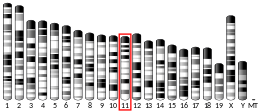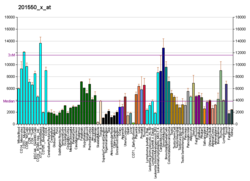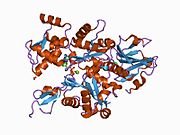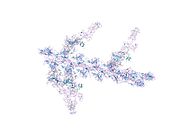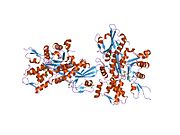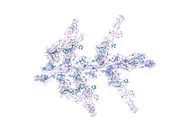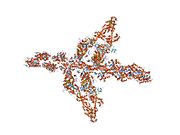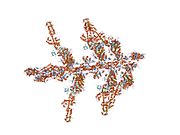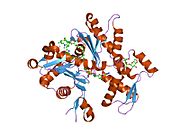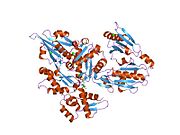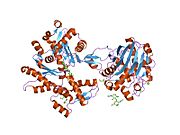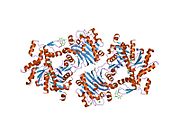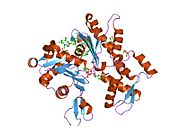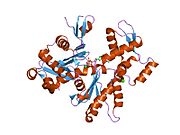액틴, 세포질 2
Actin, cytoplasmic 2| ACTG1 | |||||||||||||||||||||||||
|---|---|---|---|---|---|---|---|---|---|---|---|---|---|---|---|---|---|---|---|---|---|---|---|---|---|
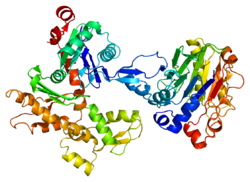 | |||||||||||||||||||||||||
| |||||||||||||||||||||||||
| 식별자 | |||||||||||||||||||||||||
| 에일리어스 | ACTG1, ACT, ACTG, BRWS2, DFNA20, DFNA26, HEL-176, 액틴 감마 1 | ||||||||||||||||||||||||
| 외부 ID | OMIM: 102560 MGI: 87906 HomoloGene: 74402 GenCards: ACTG1 | ||||||||||||||||||||||||
| |||||||||||||||||||||||||
| |||||||||||||||||||||||||
| |||||||||||||||||||||||||
| |||||||||||||||||||||||||
| 맞춤법 | |||||||||||||||||||||||||
| 종. | 인간 | 마우스 | |||||||||||||||||||||||
| 엔트레즈 | |||||||||||||||||||||||||
| 앙상블 | |||||||||||||||||||||||||
| 유니프로트 | |||||||||||||||||||||||||
| RefSeq(mRNA) | |||||||||||||||||||||||||
| RefSeq(단백질) | |||||||||||||||||||||||||
| 장소(UCSC) | Chr 17: 81.51 ~81.52 Mb | Chr 11: 120.24 ~120.24 Mb | |||||||||||||||||||||||
| PubMed 검색 | [3] | [4] | |||||||||||||||||||||||
| 위키데이터 | |||||||||||||||||||||||||
| |||||||||||||||||||||||||
액틴, 세포질 2 또는 감마 액틴은 ACTG1 [5]유전자에 의해 인간에게 암호화되는 단백질이다.감마-액틴은 많은 조직의 세포 골격에서 널리 발현된다. 성체 줄무늬 근육 세포에서 감마-액틴은 근육 세포에서 힘 전달과 전달을 담당하는 Z-디스크와 늑골 구조에 국소화된다.ACTG1의 돌연변이는 비신드롬성 난청 및 Baraitser-Winter 증후군과 관련이 있을 뿐만 아니라 청소년 환자의 빈크리스틴 독성에 대한 감수성과 관련이 있다.
구조.
인간의 감마-액틴은 분자량이 41.8kDa이고 아미노산이 [6]375개이다.액틴은 세포 운동성의 다양한 형태와 세포 골격의 유지에 관여하는 고도로 보존된 단백질이다.척추동물에서 액틴 패럴로그의 세 가지 주요 그룹인 알파, 베타, 감마 그룹이 확인되었다.[7]
알파 액틴은 근육 조직에서 발견되며 육식 수축 기구의 주요 구성 요소입니다.베타액틴과 감마액틴은 대부분의 세포 유형에서 세포골격의 구성 요소 및 내부 세포 운동의 매개체로 공존합니다.이 유전자에 의해 코드된 액틴, 감마 1은 세포질의 비근육 세포와 늑골 구조의 근육 세포 또는 근구의 [8][9][10]장축에 수직으로 이어지는 세포-세포 접착의 횡점에서 발견된다.
기능.
근세포에서, 육갑상선들은 늑골을 통해 Z-디스크와 M-라인에 [11]정렬된 육갑상선에 부착됩니다.골격의 두 가지 주요 세포골격 구성 요소는 데스민 중간 필라멘트와 감마-액틴 미세 [12]필라멘트이다.세포골격과 근막 [13][14]사이에 기계적으로 강한 연결을 형성하기 위해 또 다른 골격 단백질 디스트로핀과 상호작용하는 감마 액틴이 매우 중요한 것으로 나타났다.추가 연구에 따르면 감마-액틴은 Z-디스크에 국소화된 알파-액티닌과 GFP 라벨이 부착된 감마 액틴으로 열원소화하는 반면, GFP-알파-액틴은 얇은 필라멘트의 뾰족한 끝에 국소화되어 감마 액틴이 줄무늬 근육 세포에서 [15][16][17]Z-디스크에 특이적으로 국소화되는 것으로 나타났다.
근구의 발달 동안, 감마 액틴은 알파 액티닌에 [18]의한 초기 열량화에서 부분적으로 증명되는, 육갑상선 발육의 조직과 조립에 역할을 하는 것으로 생각된다.감마-액틴은 결국 Z-디스크 및 코스타메어 [15][22][23]도메인과 관련된 성체 근세포에서 낮은 수준의 감마-액틴이 지속되면서 육질 알파-액틴 [19][20][21]동소로 대체된다.
근육에서 감마-액틴의 기능에 대한 통찰은 트랜스제네시스를 이용한 연구에서 나왔다.생쥐의 골격근 특이적 감마액틴 녹아웃에서 이러한 동물들은 눈에 띄는 발달 이상을 보이지 않았다. 그러나 녹아웃 생쥐들은 등축성 경련력 감소와 함께 근섬유내와 근섬유간 연결을 방해하고 [24]근병증을 보였다.
임상적 의의
17q25-qter에서 DFNA20/26 궤적의 ACTG1에서 상염색체 우성 돌연변이가 난청 환자에서 확인되었다.단백질 구조를 변화시킬 것으로 예상되는 감마-액틴 단백질의 나선 9에서 Thr278Ile 돌연변이가 확인되었다.이 연구는 감마-액틴의 돌연변이를 일으키는 첫 번째 질병을 확인했으며 내이모세포의 [25]구조 요소로서 감마-액틴의 중요성을 뒷받침했다.그 이후로, Met305Thr을 [26]포함한 다른 ACTG1 돌연변이는 비신드롬성 난청과 관련이 있었다.
Ser155Phe에서 ACTG1의 미스센스 돌연변이는 선천성 안검하수증, 과도하게 아치형 눈썹, 고피로증, 안구콜로보마타, 간질증, 단신 발작 및 [27][28]청력 손실을 특징으로 하는 발달 장애인 Baraitser-Winter 증후군 환자에서도 확인되었다.
ACTG1 mRNA의 차등 표현은 또한 Affymetrix [29]롱올리고뉴클레오티드 BaFL 방법을 사용하는 정교한 생체정보학 접근방식을 사용하여 원인이 불분명한 파괴적 질환인 산발적 근위축성 측삭경화증 환자에서도 확인되었다.
ACTG1의 단일 뉴클레오티드 다형은 소아 급성 림프아구성 백혈병에 대한 표준 치료 요법의 일부인 빈크리스틴 독성과 관련이 있다.신경독성은 ACTG1 Gly310Ala 돌연변이 운반체 환자에서 더 자주 발생했으며, 이는 빈크리스틴 [30]치료의 환자 결과에 영향을 미칠 수 있음을 시사했다.
상호 작용
ACTG1은 다음과 상호작용하는 것으로 나타났습니다.
「 」를 참조해 주세요.
레퍼런스
- ^ a b c GRCh38: 앙상블 릴리즈 89: ENSG00000184009 - 앙상블, 2017년 5월
- ^ a b c GRCm38: 앙상블 릴리즈 89: ENSMUSG000062825 - 앙상블, 2017년 5월
- ^ "Human PubMed Reference:". National Center for Biotechnology Information, U.S. National Library of Medicine.
- ^ "Mouse PubMed Reference:". National Center for Biotechnology Information, U.S. National Library of Medicine.
- ^ "Entrez Gene: ACTG1 actin, gamma 1".
- ^ "Protein sequence for human ACTG1 (Uniprot ID: P63261)". Cardiac Organellar Protein Atlas Knowledgebase (COPaKB). Archived from the original on 21 July 2015. Retrieved 18 July 2015.
- ^ Rubenstein PA (Jul 1990). "The functional importance of multiple actin isoforms". BioEssays. 12 (7): 309–15. doi:10.1002/bies.950120702. PMID 2203335. S2CID 2163289.
- ^ Craig SW, Pardo JV (1983). "Gamma actin, spectrin, and intermediate filament proteins colocalize with vinculin at costameres, myofibril-to-sarcolemma attachment sites". Cell Motility. 3 (5–6): 449–62. doi:10.1002/cm.970030513. PMID 6420066.
- ^ Pardo JV, Siliciano JD, Craig SW (Feb 1983). "A vinculin-containing cortical lattice in skeletal muscle: transverse lattice elements ("costameres") mark sites of attachment between myofibrils and sarcolemma". Proceedings of the National Academy of Sciences of the United States of America. 80 (4): 1008–12. Bibcode:1983PNAS...80.1008P. doi:10.1073/pnas.80.4.1008. PMC 393517. PMID 6405378.
- ^ Danowski BA, Imanaka-Yoshida K, Sanger JM, Sanger JW (Sep 1992). "Costameres are sites of force transmission to the substratum in adult rat cardiomyocytes". The Journal of Cell Biology. 118 (6): 1411–20. doi:10.1083/jcb.118.6.1411. PMC 2289604. PMID 1522115.
- ^ Clark KA, McElhinny AS, Beckerle MC, Gregorio CC (2002). "Striated muscle cytoarchitecture: an intricate web of form and function". Annual Review of Cell and Developmental Biology. 18: 637–706. doi:10.1146/annurev.cellbio.18.012502.105840. PMID 12142273.
- ^ Kee AJ, Gunning PW, Hardeman EC (2009). "Diverse roles of the actin cytoskeleton in striated muscle". Journal of Muscle Research and Cell Motility. 30 (5–6): 187–97. doi:10.1007/s10974-009-9193-x. PMID 19997772. S2CID 6632615.
- ^ a b Rybakova IN, Patel JR, Ervasti JM (Sep 2000). "The dystrophin complex forms a mechanically strong link between the sarcolemma and costameric actin". The Journal of Cell Biology. 150 (5): 1209–14. doi:10.1083/jcb.150.5.1209. PMC 2175263. PMID 10974007.
- ^ Ervasti JM (Apr 2003). "Costameres: the Achilles' heel of Herculean muscle". The Journal of Biological Chemistry. 278 (16): 13591–4. doi:10.1074/jbc.R200021200. PMID 12556452.
- ^ a b Nakata T, Nishina Y, Yorifuji H (Aug 2001). "Cytoplasmic gamma actin as a Z-disc protein". Biochemical and Biophysical Research Communications. 286 (1): 156–63. doi:10.1006/bbrc.2001.5353. PMID 11485322.
- ^ Papponen H, Kaisto T, Leinonen S, Kaakinen M, Metsikkö K (Jan 2009). "Evidence for gamma-actin as a Z disc component in skeletal myofibers". Experimental Cell Research. 315 (2): 218–25. doi:10.1016/j.yexcr.2008.10.021. PMID 19013151.
- ^ Vlahovich N, Kee AJ, Van der Poel C, Kettle E, Hernandez-Deviez D, Lucas C, Lynch GS, Parton RG, Gunning PW, Hardeman EC (Jan 2009). "Cytoskeletal tropomyosin Tm5NM1 is required for normal excitation-contraction coupling in skeletal muscle". Molecular Biology of the Cell. 20 (1): 400–9. doi:10.1091/mbc.E08-06-0616. PMC 2613127. PMID 19005216.
- ^ Lloyd CM, Berendse M, Lloyd DG, Schevzov G, Grounds MD (Jul 2004). "A novel role for non-muscle gamma-actin in skeletal muscle sarcomere assembly". Experimental Cell Research. 297 (1): 82–96. doi:10.1016/j.yexcr.2004.02.012. PMID 15194427.
- ^ Schwartz RJ, Rothblum KN (Jul 1981). "Gene switching in myogenesis: differential expression of the chicken actin multigene family". Biochemistry. 20 (14): 4122–9. doi:10.1021/bi00517a027. PMID 7284314.
- ^ Shani M, Zevin-Sonkin D, Saxel O, Carmon Y, Katcoff D, Nudel U, Yaffe D (Sep 1981). "The correlation between the synthesis of skeletal muscle actin, myosin heavy chain, and myosin light chain and the accumulation of corresponding mRNA sequences during myogenesis". Developmental Biology. 86 (2): 483–92. doi:10.1016/0012-1606(81)90206-2. PMID 7286410.
- ^ von Arx P, Bantle S, Soldati T, Perriard JC (Dec 1995). "Dominant negative effect of cytoplasmic actin isoproteins on cardiomyocyte cytoarchitecture and function". The Journal of Cell Biology. 131 (6 Pt 2): 1759–73. doi:10.1083/jcb.131.6.1759. PMC 2120671. PMID 8557743.
- ^ Hanft LM, Bogan DJ, Mayer U, Kaufman SJ, Kornegay JN, Ervasti JM (Jul 2007). "Cytoplasmic gamma-actin expression in diverse animal models of muscular dystrophy". Neuromuscular Disorders. 17 (7): 569–74. doi:10.1016/j.nmd.2007.03.004. PMC 1993539. PMID 17475492.
- ^ Kee AJ, Schevzov G, Nair-Shalliker V, Robinson CS, Vrhovski B, Ghoddusi M, Qiu MR, Lin JJ, Weinberger R, Gunning PW, Hardeman EC (Aug 2004). "Sorting of a nonmuscle tropomyosin to a novel cytoskeletal compartment in skeletal muscle results in muscular dystrophy". The Journal of Cell Biology. 166 (5): 685–96. doi:10.1083/jcb.200406181. PMC 2172434. PMID 15337777.
- ^ Sonnemann KJ, Fitzsimons DP, Patel JR, Liu Y, Schneider MF, Moss RL, Ervasti JM (Sep 2006). "Cytoplasmic gamma-actin is not required for skeletal muscle development but its absence leads to a progressive myopathy". Developmental Cell. 11 (3): 387–97. doi:10.1016/j.devcel.2006.07.001. PMID 16950128.
- ^ van Wijk E, Krieger E, Kemperman MH, De Leenheer EM, Huygen PL, Cremers CW, Cremers FP, Kremer H (Dec 2003). "A mutation in the gamma actin 1 (ACTG1) gene causes autosomal dominant hearing loss (DFNA20/26)". Journal of Medical Genetics. 40 (12): 879–84. doi:10.1136/jmg.40.12.879. PMC 1735337. PMID 14684684.
- ^ Park G, Gim J, Kim AR, Han KH, Kim HS, Oh SH, Park T, Park WY, Choi BY (18 March 2013). "Multiphasic analysis of whole exome sequencing data identifies a novel mutation of ACTG1 in a nonsyndromic hearing loss family". BMC Genomics. 14: 191. doi:10.1186/1471-2164-14-191. PMC 3608096. PMID 23506231.
- ^ Rivière JB, van Bon BW, Hoischen A, Kholmanskikh SS, O'Roak BJ, Gilissen C, Gijsen S, Sullivan CT, Christian SL, Abdul-Rahman OA, Atkin JF, Chassaing N, Drouin-Garraud V, Fry AE, Fryns JP, Gripp KW, Kempers M, Kleefstra T, Mancini GM, Nowaczyk MJ, van Ravenswaaij-Arts CM, Roscioli T, Marble M, Rosenfeld JA, Siu VM, de Vries BB, Shendure J, Verloes A, Veltman JA, Brunner HG, Ross ME, Pilz DT, Dobyns WB (Apr 2012). "De novo mutations in the actin genes ACTB and ACTG1 cause Baraitser-Winter syndrome". Nature Genetics. 44 (4): 440–4, S1–2. doi:10.1038/ng.1091. PMC 3677859. PMID 22366783.
- ^ Di Donato N, Rump A, Koenig R, Der Kaloustian VM, Halal F, Sonntag K, Krause C, Hackmann K, Hahn G, Schrock E, Verloes A (Feb 2014). "Severe forms of Baraitser-Winter syndrome are caused by ACTB mutations rather than ACTG1 mutations". European Journal of Human Genetics. 22 (2): 179–83. doi:10.1038/ejhg.2013.130. PMC 3895648. PMID 23756437.
- ^ Baciu C, Thompson KJ, Mougeot JL, Brooks BR, Weller JW (24 September 2012). "The LO-BaFL method and ALS microarray expression analysis". BMC Bioinformatics. 13: 244. doi:10.1186/1471-2105-13-244. PMC 3526454. PMID 23006766.
- ^ Ceppi F, Langlois-Pelletier C, Gagné V, Rousseau J, Ciolino C, De Lorenzo S, Kevin KM, Cijov D, Sallan SE, Silverman LB, Neuberg D, Kutok JL, Sinnett D, Laverdière C, Krajinovic M (Jun 2014). "Polymorphisms of the vincristine pathway and response to treatment in children with childhood acute lymphoblastic leukemia". Pharmacogenomics. 15 (8): 1105–16. doi:10.2217/pgs.14.68. PMC 4443746. PMID 25084203.
- ^ Hubberstey A, Yu G, Loewith R, Lakusta C, Young D (Jun 1996). "Mammalian CAP interacts with CAP, CAP2, and actin". Journal of Cellular Biochemistry. 61 (3): 459–66. doi:10.1002/(SICI)1097-4644(19960601)61:3<459::AID-JCB13>3.0.CO;2-E. PMID 8761950.
- ^ Hertzog M, van Heijenoort C, Didry D, Gaudier M, Coutant J, Gigant B, Didelot G, Préat T, Knossow M, Guittet E, Carlier MF (May 2004). "The beta-thymosin/WH2 domain; structural basis for the switch from inhibition to promotion of actin assembly". Cell. 117 (5): 611–23. doi:10.1016/S0092-8674(04)00403-9. PMID 15163409. S2CID 8628287.
- ^ Van Troys M, Dewitte D, Goethals M, Carlier MF, Vandekerckhove J, Ampe C (Jan 1996). "The actin binding site of thymosin beta 4 mapped by mutational analysis". The EMBO Journal. 15 (2): 201–10. doi:10.1002/j.1460-2075.1996.tb00350.x. PMC 449934. PMID 8617195.
- ^ Hijikata T, Nakamura A, Isokawa K, Imamura M, Yuasa K, Ishikawa R, Kohama K, Takeda S, Yorifuji H (Jun 2008). "Plectin 1 links intermediate filaments to costameric sarcolemma through beta-synemin, alpha-dystrobrevin and actin". Journal of Cell Science. 121 (Pt 12): 2062–74. doi:10.1242/jcs.021634. PMID 18505798.
외부 링크
- UCSC Genome Browser의 인간 ACTG1 게놈 위치 및 ACTG1 유전자 상세 페이지.
추가 정보
- Snásel J, Pichová I (1997). "The cleavage of host cell proteins by HIV-1 protease". Folia Biologica. 42 (5): 227–30. doi:10.1007/BF02818986. PMID 8997639. S2CID 7617882.
- Rodríguez Del Castillo A, Vitale ML, Trifaró JM (Nov 1992). "Ca2+ and pH determine the interaction of chromaffin cell scinderin with phosphatidylserine and phosphatidylinositol 4,5,-biphosphate and its cellular distribution during nicotinic-receptor stimulation and protein kinase C activation". The Journal of Cell Biology. 119 (4): 797–810. doi:10.1083/jcb.119.4.797. PMC 2289683. PMID 1331119.
- Adams LD, Tomasselli AG, Robbins P, Moss B, Heinrikson RL (Feb 1992). "HIV-1 protease cleaves actin during acute infection of human T-lymphocytes". AIDS Research and Human Retroviruses. 8 (2): 291–5. doi:10.1089/aid.1992.8.291. PMID 1540415.
- Dawson SJ, White LA (May 1992). "Treatment of Haemophilus aphrophilus endocarditis with ciprofloxacin". The Journal of Infection. 24 (3): 317–20. doi:10.1016/S0163-4453(05)80037-4. PMID 1602151.
- Tomasselli AG, Hui JO, Adams L, Chosay J, Lowery D, Greenberg B, Yem A, Deibel MR, Zürcher-Neely H, Heinrikson RL (Aug 1991). "Actin, troponin C, Alzheimer amyloid precursor protein and pro-interleukin 1 beta as substrates of the protease from human immunodeficiency virus". The Journal of Biological Chemistry. 266 (22): 14548–53. doi:10.1016/S0021-9258(18)98721-1. PMID 1907279.
- Shoeman RL, Kesselmier C, Mothes E, Höner B, Traub P (Jan 1991). "Non-viral cellular substrates for human immunodeficiency virus type 1 protease". FEBS Letters. 278 (2): 199–203. doi:10.1016/0014-5793(91)80116-K. PMID 1991513. S2CID 37002682.
- Erba HP, Eddy R, Shows T, Kedes L, Gunning P (Apr 1988). "Structure, chromosome location, and expression of the human gamma-actin gene: differential evolution, location, and expression of the cytoskeletal beta- and gamma-actin genes". Molecular and Cellular Biology. 8 (4): 1775–89. doi:10.1128/mcb.8.4.1775. PMC 363338. PMID 2837653.
- Vandekerckhove J, Schering B, Bärmann M, Aktories K (Jan 1988). "Botulinum C2 toxin ADP-ribosylates cytoplasmic beta/gamma-actin in arginine 177". The Journal of Biological Chemistry. 263 (2): 696–700. doi:10.1016/S0021-9258(19)35408-0. PMID 3335520.
- Chou CC, Davis RC, Fuller ML, Slovin JP, Wong A, Wright J, Kania S, Shaked R, Gatti RA, Salser WA (May 1987). "Gamma-actin: unusual mRNA 3'-untranslated sequence conservation and amino acid substitutions that may be cancer related". Proceedings of the National Academy of Sciences of the United States of America. 84 (9): 2575–9. Bibcode:1987PNAS...84.2575C. doi:10.1073/pnas.84.9.2575. PMC 304700. PMID 3472224.
- Hesterberg LK, Weber K (Jan 1986). "Isolation of a domain of villin retaining calcium-dependent interaction with G-actin, but devoid of F-actin fragmenting activity". European Journal of Biochemistry. 154 (1): 135–40. doi:10.1111/j.1432-1033.1986.tb09368.x. PMID 3510866.
- Erba HP, Gunning P, Kedes L (Jul 1986). "Nucleotide sequence of the human gamma cytoskeletal actin mRNA: anomalous evolution of vertebrate non-muscle actin genes". Nucleic Acids Research. 14 (13): 5275–94. doi:10.1093/nar/14.13.5275. PMC 311540. PMID 3737401.
- Fuchs E, Kim KH, Hanukoglu I, Tanese N (1984). "The evolution and complexity of the genes encoding the cytoskeletal proteins of human epidermal cells". Current Problems in Dermatology. 11: 27–44. doi:10.1159/000408662. ISBN 978-3-8055-3752-0. PMID 6686106.
- Gunning P, Ponte P, Okayama H, Engel J, Blau H, Kedes L (May 1983). "Isolation and characterization of full-length cDNA clones for human alpha-, beta-, and gamma-actin mRNAs: skeletal but not cytoplasmic actins have an amino-terminal cysteine that is subsequently removed". Molecular and Cellular Biology. 3 (5): 787–95. doi:10.1128/mcb.3.5.787. PMC 368601. PMID 6865942.
- Bretscher A, Weber K (Jul 1980). "Villin is a major protein of the microvillus cytoskeleton which binds both G and F actin in a calcium-dependent manner". Cell. 20 (3): 839–47. doi:10.1016/0092-8674(80)90330-X. PMID 6893424. S2CID 568395.
- Pedrotti B, Colombo R, Islam K (1995). "Microtubule associated protein MAP1A is an actin-binding and crosslinking protein". Cell Motility and the Cytoskeleton. 29 (2): 110–6. doi:10.1002/cm.970290203. PMID 7820861.
- Pope B, Maciver S, Weeds A (Feb 1995). "Localization of the calcium-sensitive actin monomer binding site in gelsolin to segment 4 and identification of calcium binding sites". Biochemistry. 34 (5): 1583–8. doi:10.1021/bi00005a014. PMID 7849017.
- Jesaitis AJ, Erickson RW, Klotz KN, Bommakanti RK, Siemsen DW (Nov 1993). "Functional molecular complexes of human N-formyl chemoattractant receptors and actin". Journal of Immunology. 151 (10): 5653–65. PMID 8228254.
- Hawkins M, Pope B, Maciver SK, Weeds AG (Sep 1993). "Human actin depolymerizing factor mediates a pH-sensitive destruction of actin filaments". Biochemistry. 32 (38): 9985–93. doi:10.1021/bi00089a014. PMID 8399167.
- Yu FX, Lin SC, Morrison-Bogorad M, Atkinson MA, Yin HL (Jan 1993). "Thymosin beta 10 and thymosin beta 4 are both actin monomer sequestering proteins". The Journal of Biological Chemistry. 268 (1): 502–9. doi:10.1016/S0021-9258(18)54179-X. PMID 8416954.
- Jalaguier S, Mornet D, Mesnier D, Léger JJ, Auzou G (Apr 1996). "Human mineralocorticoid receptor interacts with actin under mineralocorticoid ligand modulation". FEBS Letters. 384 (2): 112–6. doi:10.1016/0014-5793(96)00295-5. PMID 8612804. S2CID 34685894.


